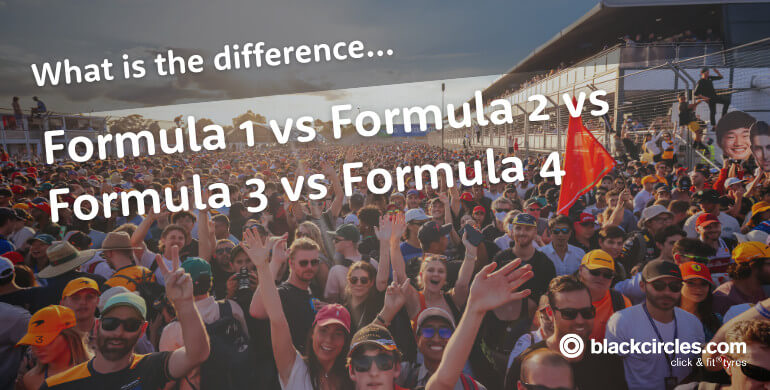Join the conversation
We love to hear from our customers. Connect with us today and let’s start a conversation.
...searching

When it comes to the world of motorsport, few things are as thrilling (or as confusing) as the various tiers of Formula racing.
Most fans are familiar with the glamour and speed of
Formula 1, but fewer understand where Formula 2, Formula 3, and Formula 4 fit into the bigger picture. Are they just slower versions of F1, or is there more to the story?
In this article, we’ll break down the real differences between each Formula category from car performance and team structure to driver development and career progression.
Whether you're a seasoned petrolhead or new to the racing world, this guide will help you navigate the fast-paced ladder that shapes future Formula 1 champions.
Formula 1 is by far the fastest and most advanced, followed by Formula 2, Formula 3, and then Formula 4.
These four series form the official FIA pathway for aspiring drivers. Each step up the ladder brings increased speed, technical complexity, and competitiveness — preparing drivers for the top tier.
Feature | Formula 1 | Formula 2 | Formula 3 | Formula 4 |
Engine Power | ~1000 hp (1.6L Turbo Hybrid) | ~620 hp (3.4L V6 NA) | ~380 hp (3.4L NA) | ~160–180 hp (1.4–2.0L) |
Top Speed | ~360 km/h | ~335 km/h | ~300 km/h | ~210–240 km/h |
0–100 km/h | ~2.6 sec | ~3.0 sec | ~3.5 sec | ~4.0–4.5 sec |
Chassis | Team-built (F1-specific) | Dallara (spec) | Dallara (spec) | Various (Mygale, Tatuus) |
Gearbox | 8-speed semi-auto | 6-speed sequential | 6-speed sequential | 5/6-speed sequential |
Race Format | 1 Grand Prix | 1 Feature + 1 Sprint | 1 Feature + 1 Sprint | Varies (often 2–3 races) |
Tyre Supplier | Pirelli | Pirelli | Pirelli | Varies (Pirelli, Hankook etc.) |
This iconic Belgian circuit hosts F1, F2, and F3 — providing a real-world benchmark for performance.
F1 is over 20 seconds faster than F2, and the time gap between each category illustrates the step-change in speed, grip, and driver skill required.
Each level in the single-seater ladder has a distinct developmental role:
Category | Tyre Supplier | Compound Variety | Tyre Strategy |
F1 | Pirelli | 5 dry + wets | Custom strategy, multiple stops |
F2 | Pirelli | 2 dry + wets | Mandatory compound change (Feature race) |
F3 | Pirelli | 1 slick + wets | No mandatory stop |
F4 | Varies (Pirelli, Hankook etc.) | 1–2 slick compounds | No pit stops (usually sprint format) |

Formula 1 is a fully open development championship, while Formula 2 is a spec series designed to train future F1 drivers.
F1 teams build and develop their own cars, engines, and components with large budgets and constant upgrades. F2 teams all run identical Dallara chassis and Mecachrome engines with strict regulations to level the playing field.
Formula 1 features hybrid power units, DRS, complex strategies, and global pressure. F2 focuses on race styles, tyre management, and preparing drivers for the intensity of F1 competition.
Formula 3 is two levels below F1 and serves as an international junior series, with slower cars, shorter races, and a tighter focus on raw talent.
F1 cars have far more power, speed, and aerodynamic grip than F3 machines. F3 is a spec series with less emphasis on tyre strategy and more on driver consistency and control.
While F1 is the goal, F3 is often the first exposure young drivers have to a global race calendar and pressure from scouts and teams higher up the ladder.
Formula 4 is the entry-level series in the FIA single-seater ladder, designed for karting graduates, while F1 is the most elite racing category in the world.
F4 cars are simple, small, and cost-controlled — ideal for learning race tactics, car control, and race procedures.
In contrast, F1 cars are the most complex and fastest machines in motorsport, requiring immense skill, technical knowledge, and team support to manage.
Formula 2 is faster, more powerful, and closer to Formula 1 in format and pressure, while Formula 3 serves as a development stage before reaching F2.
F2 cars use a 620 hp V6 engine and feature more complex race formats (Sprint and Feature races, mandatory pit stops). F3 cars use a smaller, ~380 hp engine and have simpler rules and shorter races.
F2 also introduces race strategy and tyre degradation — key stepping stones for drivers heading to Formula 1.
Formula 2 is a professional-level feeder to F1 with powerful cars and global exposure, while Formula 4 is a grassroots series for beginners.
F2 cars are much faster, heavier, and technically demanding, often racing on the same weekends as F1.
F4 is where drivers learn the fundamentals — safe overtaking, consistent lap times, and handling slick tyres and downforce — with much lower speed and stakes.
Formula 3 is the next step up from F4, introducing faster cars, international racing, and more competitive pressure.
F3 drivers deal with more advanced machinery, tougher opponents, and greater media and team scrutiny.
F4 is about learning the ropes; F3 is where careers start to gain momentum — and where top junior drivers begin to stand out.
Each level introduces more speed, pressure, and technical complexity. From learning how to handle a car in F4 to managing tyre strategy and media pressure in F2, the ladder is designed to build well-rounded drivers who can succeed in the world’s fastest, most demanding championship in Formula 1.
Formula 1 is the final destination — but F2, F3, and F4 are the essential path that gets drivers there.

We love to hear from our customers. Connect with us today and let’s start a conversation.